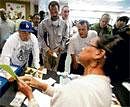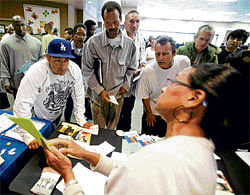

Over the last five years, from the first quarter of 2006 to the first quarter of 2011, the US economy’s growth rate averaged less than 1 per cent a year, about like Japan during the period when its bubble burst. At the same time, the fraction of the population working has fallen from 63.1 per cent to 58.4 per cent, reducing the number of those with jobs by more than 10 million. The fraction of the population working remains almost exactly at its recession trough and recent reports suggest that growth is slowing.
Beyond the lack of jobs and incomes, an economy producing below its potential for a prolonged interval sacrifices its future. To an extent that once would have been unimaginable, new college graduates are this month moving back in with their parents because they have no job or means of support. Strapped school districts across the country are cutting out advanced courses in math and science and in some cases only opening school four days a week. And reduced incomes and tax collections at present and in the future are the most important cause of unacceptable budget deficits at present and in the future.
You cannot prescribe for a malady unless you diagnose it accurately and understand its causes. Recessions are times when there is too little demand for the products of businesses, and so they fail to employ all those who want to work. That the problem in a period of high unemployment like the present one is a lack of business demand for employees, not any lack of desire to work is all but self-evident. It is demonstrated by the observations that (i) the propensity of workers to quit jobs and the level of job openings are at near-record low levels; (ii) rises in nonemployment have taken place among essentially all demographic skill and education groups; and (iii) rising rates of profit and falling rates of wage growth suggest that it is employers, not workers, who have the power in almost every market.
I belabor the idea that lack of demand is the fundamental cause of economies producing below their potential because the failure to recognise the centrality of demand can have catastrophic consequences. But for Hitler and the military buildup up he caused, FDR would have left office in early 1941 a failure, with American unemployment above 15 per cent and with the recovery promise of the New Deal shattered by the premature attempt in 1937 to reassert the traditional virtues of deficit reduction and inflation control. When I entered the Clinton administration in 1993, it was generally believed that Japan had the potential to grow its economy by 4 per cent a year going forward, enough to have doubled output from that time until now. Instead output has barely grown, a consequence of the post bubble stagnation that Japan suffered.
A sick economy constrained by demand works very differently than a normal one. Measures that usually promote growth and job creation can have little effect or can actually backfire. When demand is constraining an economy, there is little to be gained from increasing potential supply.
In a recession, if more people seek to borrow less or save more, there is reduced demand and hence fewer jobs. Training programmes or measures to increase work incentives for those with both high and low incomes may affect who gets the jobs, but in a demand-constrained economy will not affect the total number of jobs. Most paradoxically, measures that increase productivity and efficiency, if they do not also translate into increased demand, may actually reduce the number of people working as the level of total output remains demand constrained.
Traditionally, the American economy has recovered robustly from recession as demand has been quickly renewed. Within a couple of years after the only two deep recessions of the post-World War II period -- those of 1974-1975 and 1980-1982 -- the economy was growing in the range of 6 per cent or more -- rates that seem inconceivable today. Why?
Inflation dynamics defined the traditional post-war American business cycle. Recoveries continued and sometimes even accelerated until they were murdered by the Federal Reserve with inflation control as the motive. When the Fed became concerned about inflation accelerating, usually too late, it raised interest rates and crunched credit, stifling housing, business investment, and consumer durable purchases and causing the economy to go into recession. After inflation slowed, rapid recovery propelled by dramatic reductions in interest rates and a backlog of deferred investment was almost inevitable.
Our current situation is very different. With more prudent monetary policies, expansions are no longer cut short by rising inflation and the Fed hitting the brakes. All three American expansions since Paul Volcker brought inflation back under control have run long. They end after a period of overconfidence drives the prices of capital assets too high and the apparent increases in wealth give rise to excessive borrowing, lending and spending.
After bubbles burst, there is no pent-up desire to invest. Instead, there is a glut of capital caused by over investment during the period of confidence: vacant houses, malls without tenants, and factories without customers. At the same time, consumers discover that they have less wealth than they expected, less collateral to borrow against and are under more pressure than they expected from their creditors. Little wonder that private spending collapses and that post-bubble economic downturns often last more than a decade and are only ended through external events like military buildups.
Pressure on private spending is enhanced by structural changes. Take as a vivid example the publishing industry. As local bookstores have given way to megastores, megastores have given way to Internet retailers, and Internet retailers have given way to ebooks, two things have happened. The economy’s productive potential has increased and its ability to generate demand that fulfills the potential has been compromised as resources have been transferred from middle-class retail and wholesale workers with a high propensity to spend up the scale to those with a much lower propensity to spend. And the need for capital investment in distribution networks has come down.
What then is to be done? This is no time for fatalism or for traditional political agendas that the two parties have pushed in more normal times. The central irony of financial crisis is that while it is caused by too much confidence, borrowing and lending, and spending, it is only resolved by increases in confidence, borrowing and lending, and spending. It follows that the central objective of national economic policy until sustained recovery is firmly established must be increasing confidence, borrowing and lending, and spending. Unless and until this is done, other policies, no matter how apparently appealing or effective in normal times, will be futile at best. We should recognise that it is a false economy to defer infrastructure maintenance and replacement, and instead take advantage of a moment when 10-year interest rates are below 3 per cent and construction unemployment approaches 20 per cent to expand infrastructure investment.
It is far too soon for financial policy to shift toward preventing future bubbles and possible inflation and away from assuring adequate demand. The underlying rate of inflation is still trending downward, and the problems of insufficient borrowing and investing exceed any problems of overconfidence. The Dodd-Frank legislation is a broadly appropriate response to the hugely important challenge of preventing any recurrence of the events of 2008. It needs to be vigorously implemented. But under, not over-confidence is the problem of the moment and needs to be the focus of policy.
Most important, the fiscal debate needs to take on board the reality that the greatest threat to the nation’s creditworthiness is a sustained period of slow growth that, as in southern Europe, causes debt-GDP ratios to soar. This means that essential discussions about medium-term measures to restrain spending and raise revenues need to be coupled with a focus on near-term growth. Without the payroll tax cuts and unemployment insurance negotiated by the president and Congress last fall we might well be looking today at the possibility of a double dip. Substantial withdrawal of fiscal support for demand at the end of 2011 would be premature. Fiscal support should be continued and indeed expanded by providing the payroll tax cut to employers as well as employees. Raising the share of the payroll tax cut from 2 per cent to 3 per cent would be desirable as well. At a near-term cost of a little over $200 billion, these measures offer the prospect of significant improvement in economic performance over the next few years translating into significant increases in the tax base and reductions in necessary government outlays.
It is appropriate that policy in other dimensions be informed by the shortage of demand that is a defining characteristic of our economy. For example, the Obama administration is doing important work in promoting export growth by modernising export controls, promoting US products abroad and reaching and enforcing trade agreements. Much more could be done through changes in visa policy, for example, to promote exports of tourism as well as education and health services. In a similar vein, recent presidential directives regarding relaxation of inappropriate regulatory burdens should be rigorously implemented to boost confidence. Perhaps the most fundamental strength of the United States is its resilience. We averted Depression by acting decisively in 2008 and 2009. Now we can avert a lost decade by recognising current economic reality.
(The writer is Charles W Eliot University Professor at Harvard University and a former US Treasury secretary)